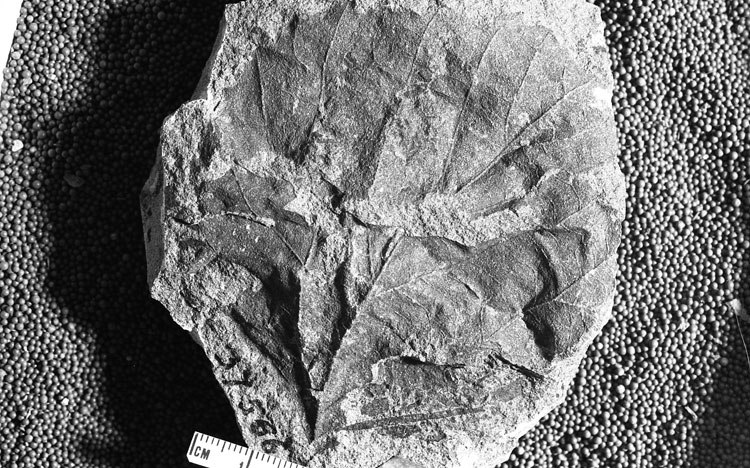Locality
From Hollick (1930) (p. 85-86)
"Yukon River, north bank, at Fossil Bluff, about 6 miles above Nahochatilton (original No. 2AC238); collected by A. J. Collier and Sidney Paige in 1902 (lot 2962) (pl. 28, fig. 5b). Yukon River, north bank, about 6 miles above Nahochatilton (original No. 3AH16); collected by Arthur Hollick and Sidney Paige in 1903 (lot 3252) (pl. 52, fig. 1)."
Description
From Hollick (1930) (p. 85-86)
"Plate 28, Figure 5b; Plate 52, Figure 1"
"Leaf obovate-orbicular, asymmetric, 8 centimeters in length by 8 centimeters in maximum width, broadly wedged-shaped from above the middle to the apex, rounded below and terminating in an abruptly constricted, short, acute, cuneate base; margin coarsely serrate-dentate from the middle upward, becoming finely dentate and entire below; nervation pinnate subtripalmate, craspedodrome; midrib curved; secondary nerves five on each side, opposite or subopposite, subparallel, leaving the midrib at acute angles of divergence, except the upper ones, which subtend more obtuse angles, the lowest pairs simulating lateral primaries, suprabasilar, flexuous, branched on the under sides, the branches curving upward."
Remarks
From Hollick (1930) (p. 85-86)
"These leaves, although evidently more or less distorted, are apparently normally asymmetric or curved to one side. They possess the character of both Platinus and Grewiopsis and may be compared with the type of leaves represented by Platinus? sp. Knowlton (1917) (p. 269, pl. 42, fig. 3) from the Vermejo formation of southeastern Colorado, and Grewiopsis populifolia Ward (1886; 1887) (p. 556, pl. 55, figs. 8 - 10; p. 90, pl. 40 figs. 3 - 5) from the Fort Union formation of Montana. The generic reference is questioned in view of the diverse opinions that have been expressed in regard to the generic affiliations of leaves of this general type, some of which have been referred to the genera previously mentioned and others to the genera Cissites and Populites (Lesquereux 1876) (Cissites affinis p. 352); (Lesquereux 1883) (Cissites affinis p. 67 [=Poplites affinis Lesquereux, The Cretaceous fiora: U. S. Geol. Survey Terr. Rept., vol. 6, p. 71, pl. 4, fig. 4, 1874]); (Heer 1883) (Cissites affinis p. 28, pl. 57, fig. 4; pl. 58, fig. 1; pl. 59, fig. 7), (Dawson 1885 [1886]) (Cissites affinis p. 12, pl. 4,fig. 2) in connection with many of which the resemblances are more apparent than the differences."
